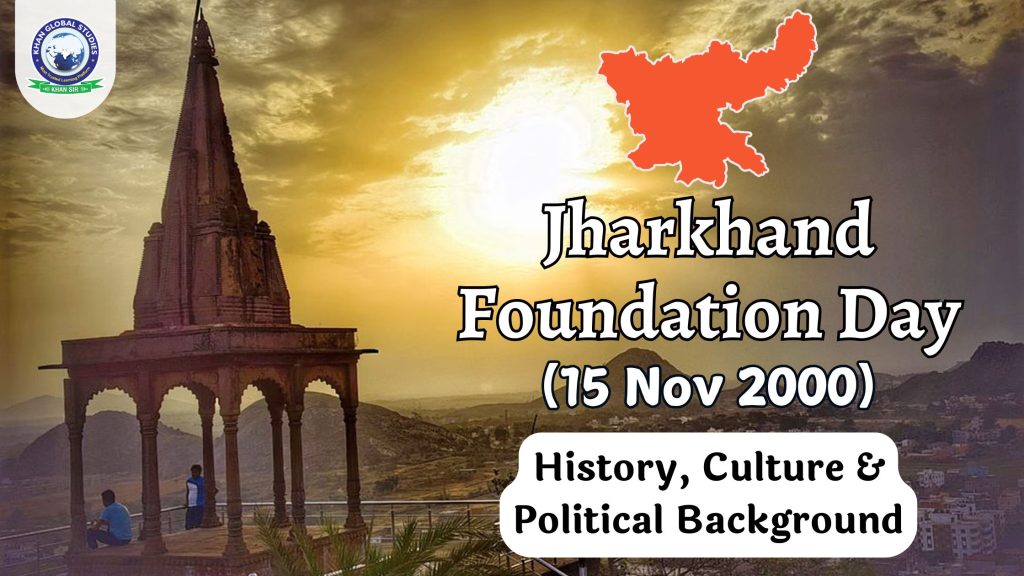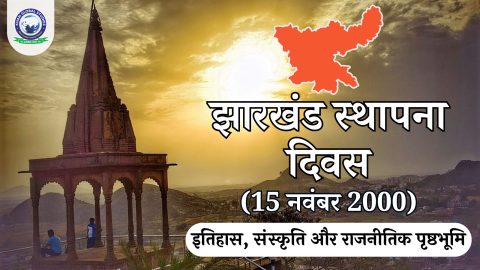Jharkhand, called the “land of forests”, is an important state located in the eastern part of India. The state came into existence on 15 November 2000 by separating from Bihar. Jharkhand literally means “Jhar” (forest) and “Khand” (piece), i.e. the land of forests.
The state is bordered by West Bengal, Odisha, Chhattisgarh, Uttar Pradesh and Bihar. Along with being the 15th largest state, it ranks 14th in terms of population. The capital of Jharkhand is Ranchi, while Dumka serves as the sub-capital. Jharkhand is known for its natural beauty, religious places and mineral resources.
Foundation of Jharkhand
The state of Jharkhand was established on 15 November 2000. The state was formed on the birth anniversary of tribal leader and freedom fighter Birsa Munda, who fought for tribal rights.
History of Jharkhand
Ancient History
The history of Jharkhand dates back to the Mesolithic and Chalcolithic periods. Places like the Ise cave paintings of Hazaribagh and the Kabra-Kala Mound of Palamu bear testimony to the fact that the region has been a centre of human settlement since ancient times. The Mahabharata refers to it as “Kark Khand”. Tribal groups developed their unique culture and traditions in the forests and hills here.
Medieval history
Chinese traveller Hiuen Tsang also mentioned this region in the 7th century. In the medieval period, Jharkhand was dominated by Nagavanshi, Chero and Munda rulers. Even during the Mughal Empire, this region remained on the border, where local tribes maintained their independence. There were conflicts between the regional kings and the Mughal Empire.
Modern History
During British rule, the Jharkhand region was known as the Chotanagpur Plateau and Santhal Pargana. The Santhal Rebellion of 1855 and Birsa Munda’s Ulgulan of 1900 proved to be milestones in the freedom movement.
During the Mughal rule, the region was conquered by Rajput king Mansingh. Brave warriors of Jharkhand like Tilka Manjhi, Sidhu-Kanhu and Birsa Munda played an important role in the 1857 freedom struggle.
Art, Culture and Dance
The culture of Jharkhand is deeply rooted in the traditions of its tribes and local communities. Tribal dance, music and folklore play a major role in the culture of Jharkhand. Major dance forms include Sarhul, Karma and Jadoor. Traditional art forms such as Sohrai and Kohbar are also popular in the state.
The major folk dances here are Sarhul, Paika, Chhau and Jadoor. Chhau dance, which is based on traditional stories and epics, is included in the UNESCO Intangible Cultural Heritage List.
Handicrafts and Workmanship
Jharkhand is famous for its handicrafts, such as tussar silk, wood carving, bamboo work, brassware, and dokra art. These crafts depict elements of tribal life and nature. Toys and jewellery made from sandalwood are also a hallmark of the state.
Education
In recent years, the state has made progress in the field of education. It has several prestigious institutes, such as the Indian School of Mines, Dhanbad, and the Birla Institute of Technology, Mesra.
The state has prestigious institutes such as the Birla Institute of Technology (BITS Mesra), Ranchi University, and IIM Ranchi. There are several government and non-government initiatives to encourage education in tribal areas.
Traditional Food
The traditional food of Jharkhand is simple and rich in nutrients. Some of the popular dishes are:
- Dhuska: A fried dish made from rice and urad dal.
- Chilka Roti: A roti made from rice flour.
- Pitha: A sweet made from rice flour and jaggery.
- Hadia: A traditional drink made from rice.
Current Status and New Initiatives
Currently, Jharkhand is in the news for its mineral wealth and industrial development. Along with this, new initiatives are also being taken in the field of agriculture and green energy. The Jharkhand government has recently launched several schemes for water conservation and environmental protection.
Major tourist spots
- Ranchi – The capital city of Ranchi is famous for its waterfalls and lush green landscapes. Hundru Falls, Dasam Falls, and Ranchi Lake are the main attractions.
- Deoghar – Deoghar is the religious centre of Jharkhand. The Baidyanath Jyotirlinga here attracts millions of devotees.
- Netarhat – Netarhat is called the “Queen of Chotanagpur”. This place is known for its spectacular sunrise and sunset views.
- Parasnath Hills – It is a major pilgrimage site of Jainism. People come here for a spiritual experience in its serene environment.
- Palamu Fort – Palamu Fort is a symbol of Jharkhand’s historical glory. This fort was built by the Nagavanshi kings.
Political Background
The politics of Jharkhand has been mainly between two parties, the Bharatiya Janata Party (BJP) and the Jharkhand Mukti Morcha (JMM). Currently, there is a government led by the JMM. Issues like tribal issues, management of mineral resources, and employment are always in discussion in the state.
Conclusion
Jharkhand holds a special place due to its natural beauty, cultural heritage and mineral resources. The state is moving ahead on the path of its development, but challenges still remain in the fields of health, education, and employment.
FAQs
Question: When was Jharkhand formed?
Answer: Jharkhand was formed on 15 November 2000.
Question: Which is the largest city in Jharkhand?
Answer: Ranchi is the largest and capital city of Jharkhand.
Question: Which is the main language of Jharkhand?
Answer: The main languages of Jharkhand are Hindi, Santhali, Mundari, Ho, and Nagpuri.
Question: What is Jharkhand famous for?
Answer: Jharkhand is famous for mineral resources, waterfalls, tribal culture, and handicrafts.
Question: What are the famous tourist places in Jharkhand?
Answer: Baidyanath Dham, Ranchi, Deoghar, Netarhat, Parasnath Hills, and Palamu Fort are the major tourist places.
Question: Which is the main festival of Jharkhand?
Answer: Sarhul, Karam, and Makar Sankranti are the major festivals in Jharkhand.




